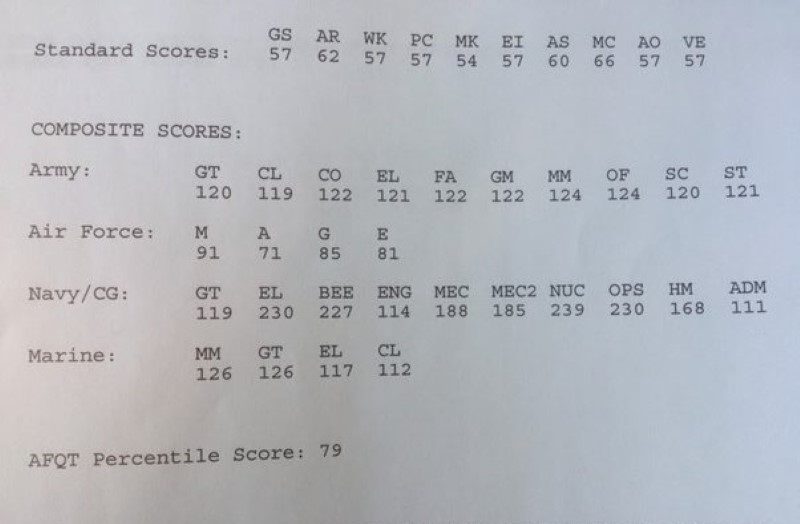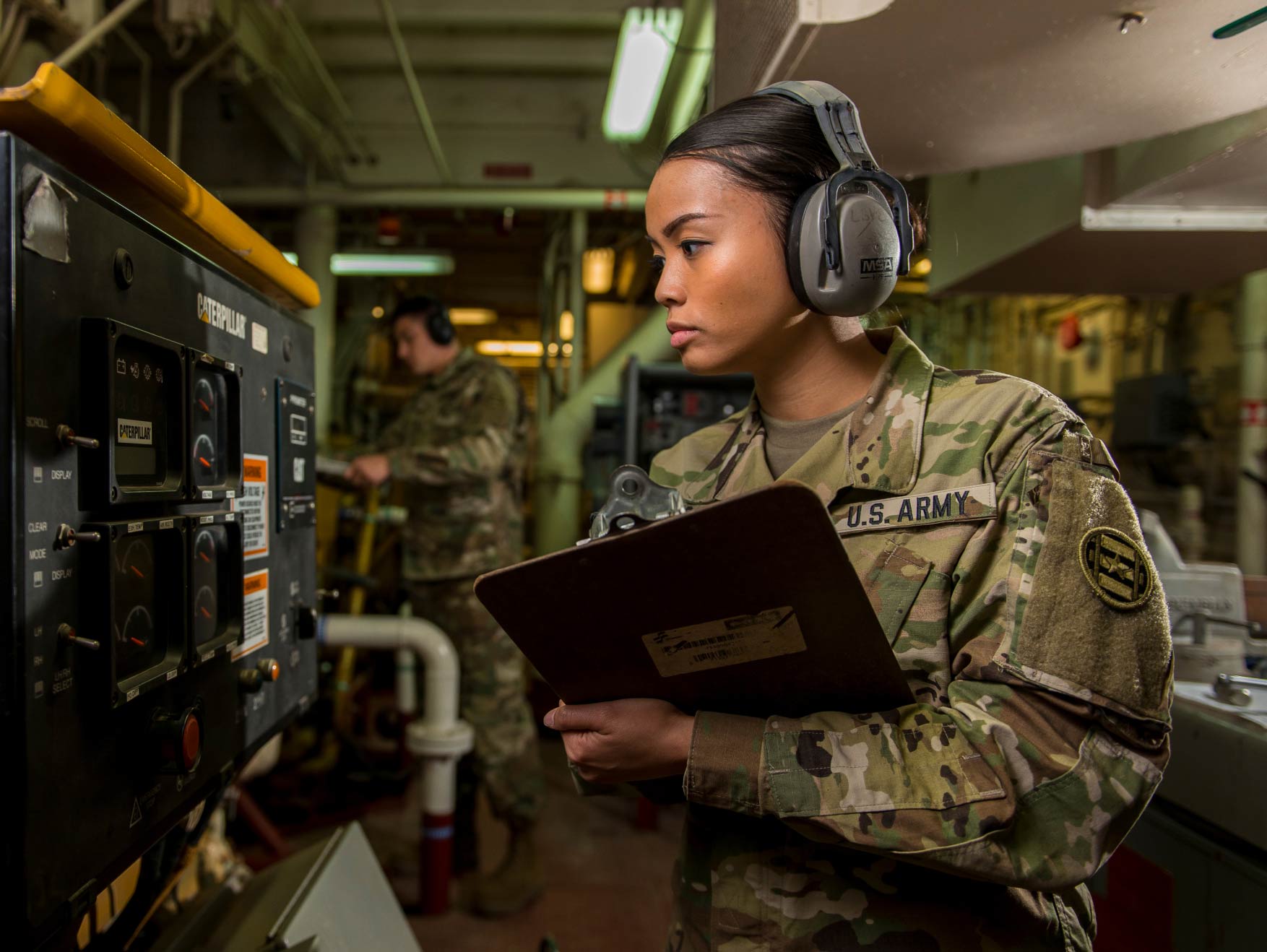ASVAB score is one of the most important criteria to determine which branch jobs you are qualified for, specifically jobs in the Air Force. Different positions in the Air Force require different score minimums, which can make you confused.
Therefore, we provide you with this comprehensive post about everything you need to know about the ASVAB scores for Air Force jobs. Reading this post, you will definitely know all the Air Force ASVAB requirements and the most suitable job for your scores. Scroll down for details!
How to calculate the Air Force ASVAB score?
Before exploring potential jobs for your ASVAB scores, it’s essential to understand how your ASVAB scores are calculated. Here’s a step-by-step guide:
Step 1. Obtain raw scores
Your raw scores are the number of correct answers on each of the ASVAB subtests. These raw scores are the foundation of your overall ASVAB performance. Accurate raw scores are crucial as they reflect your basic proficiency in each subject area.

Step 2. Convert raw scores to standard scores
Raw scores are converted to standard scores, which compare your performance to the average participants. This standardization allows for a fair assessment across different test versions. The conversion ensures that scores are comparable, regardless of when or where you took the test.
Step 3. Combine Air Force line scores
Air Force line scores or composite scores are calculated by combining standard scores from key ASVAB subtests relevant to various job roles. The line score of the Air Force includes scores in four areas, known as MAGE, as the table below:
| Line score area | Line score area |
|---|---|
| M - mechanical | Combination of arithmetic reasoning (AR), two times verbal expression (WK plus PC), mechanical comprehension (MC), auto and shop Information (AS) |
| A - administrative | Combination of numerical operations (NO), coding speed (CS), and verbal expression (WK plus PC) |
| G - general | Combination of verbal expression (WK plus PC) and arithmetic reasoning (AR) |
| E - electrical | Combination of arithmetic reasoning (AR), mathematics knowledge (MK), electronics information (EI), and general science (GS) |
These scores determine your eligibility for different Air Force roles, such as electronics or mechanics positions. Read our post on ASVAB line scores for a deeper understanding.
Step 4. Determine AFQT score
The AFQT score is derived from four critical subtests: Arithmetic Reasoning, Word Knowledge, Paragraph Comprehension, and Mathematics Knowledge. This score is crucial for determining your overall eligibility for the Air Force enlistment. A higher AFQT score increases your chances of qualifying for more roles.
Step 5. Match with the Air Force score requirement
Each job in the Air Force has specific ASVAB score requirements. Matching your scores with these requirements helps identify suitable job opportunities.
Air Force ASVAB score calculator
Understanding how to calculate your ASVAB is essential to choose a suitable Air Force job. However, the complex scoring process can make you confused and make mistakes. Therefore, we provide you with a Air Force ASVAB score calculator. This tool simplifies the process, providing you with accurate AFQT and composite scores tailored to Air Force requirements.
Follow these simple steps:
Step 1. Enter your scores into the calculator
Click on our calculator and input your scores for each subtest.
Step 2. Wait to get your results
Your results will be computed instantly by the calculator, providing you with the exact AFQT percentile score and composite scores required for Air Force enlistment.
By utilising our calculator, you can focus on being ready for an Air Force career rather than worrying about difficult maths problems. Give it a try!
Minimum ASVAB score requirements for the Air Force

To find the jobs you qualify for in the Air Force, understanding the minimum Air Force ASVAB score is crucial. AFQT score is used to determine your minimum eligibility for entering the Air Force. According to the Air Force, generally, there are two different score requirements for two distinct groups:
- Participants with a high school diploma: you need a minimum AFQT score of 31
- Participants with a GED degree: the minimum required AFQT score increases to 50.
Additionally, your ASVAB score needs to be 50 or above to be eligible for some of the benefits that are given when you enlist.
ASVAB scores for Air Force Specialty Codes (AFSC)
Besides the general minimum AFQT score, particular MAGE scores are taken into consideration to find the most suitable job positions for applicants. Roles in the Air Force are encoded by the Air Force Specialty Code, known as AFSC. Each AFSC is equivalent to a job title in the Air Force, requiring a specific MAGE area minimum score. For instance, the Air Force fire protection ASVAB score can differ from the Air Force ASVAB score for security forces. Here is the list of the ASVAB score requirements for the US AFSC:
US Air Force ASVAB score requirements by AFSC
| AFSC | Air Force title | MAGE are minimum scores |
|---|---|---|
| 1A0X1 | In-flight refueling | G55 |
| 1A1X1 | Flight engineer | G57 |
| 1A2X1 | Aircraft loadmaster | G57 |
| 1A3X1 | Airborne communication systems | E70 |
| 1A6X1 | Flight attendant | A28 |
| 1A8X1 | Airborne cryptologic language analyst | G72 |
| 1A8X2 | Airborne intelligence, surveillance, and reconnaissance (ISR) operator | G72 |
| 1A9X1 | Special missions aviation | M60 & G57 |
| 1B4X1 | Cyber warfare operations | G64 |
| 1C0X2 | Aviation resource management | A41 |
| 1C1X1 | Air traffic control | G55 |
| 1C2X1 | Combat control | M55 & G55 |
| 1C3X1 | Command and control operations | A55 & G67 |
| 1C4X1 | Tactical Air Control Party (TACP) | G49 |
| 1C5X1 | Command and control battle management operations | G55 |
| 1C6X1 | Space systems operations | E70 |
| 1C7X1 | Airfield management | M40 & G50 |
| 1C8X3 | Radar airfield and weather systems (RAWS) | E70 |
| 1N0X1 | Intelligence applications | A64 |
| 1N1X1 | Geospatial intelligence analyst | G66 |
| 1N2X1 | Signals intelligence analyst | G72 |
| 1N3X1 | Cryptologic language analyst | G72 |
| 1N4X1 | Fusion analyst | G62 |
| 1N7X1 | Human intelligence specialist | G72 |
| 1P0X1 | Aircrew flight equipment | M40 |
| 1S0X1 | Safety | G55 |
| 1T0X1 | Survival evasion, resistance, and escape (SERE) | G55 |
| 1T2X1 | Pararescue | G44 |
| 1U0X1 | Remotely piloted aircraft (RPA) sensor operator | G64 or E54 |
| 1U1X1 | Remotely piloted aircraft (RPA) pilot | G64 & E54 |
| 1W0X1 | Weather | G66 & E50 |
| 1W0X2 | Special operations weather | G66 & E50 |
| 2A0X1 | Avionics test station and component | E70 |
| 2A2X1 | Special operations forces/personnel recovery (SOF/PR) integrated communication/navigation/mission systems | E70 |
| 2A2X2 | Special operations forces/personnel recovery (SOF/PR) integrated instrument and flight control systems | E70 |
| 2A2X3 | Special operations forces/personnel recovery (SOF/PR) integrated electronic warfare systems | E70 |
| 2A3X3 | Tactical aircraft maintenance | M47 |
| 2A3X4 | Flight aircraft integrated avionics | E70 |
| 2A3X5 | Advanced fighter aircraft integrated avionics | E70 |
| 2A3X7 | Tactical aircraft maintenance (5th generation) | M47 |
| 2A3X8 | Remotely piloted aircraft maintenance | M47 |
| 2A5X1 | Airlift/special mission aircraft maintenance | M47 |
| 2A5X2 | Helicopter/tiltrotor aircraft maintenance | M56 |
| 2A5X3 | Mobility Air Force electronic warfare systems | E70 |
| 2A5X4 | Refuel/bomber aircraft maintenance | M47 |
| 2A6X1 | Aerospace propulsion (jet engines, turboprop and turboshaft) | M56 |
| 2A6X2 | Aerospace ground equipment | M47 & E28 |
| 2A6X3 | Aircrew egress systems | M56 |
| 2A6X4 | Aircraft fuel systems | M47 |
| 2A6X5 | Aircraft hydraulic systems | M56 |
| 2A6X6 | Aircraft electrical and environmental systems | M41 & E61 |
| 2A7X1 | Aircraft metals technology | M47 |
| 2A7X2 | Nondestructive inspection | M42 |
| 2A7X3 | Aircraft structural maintenance | M47 |
| 2A7X5 | Low observable aircraft structural maintenance | M47 |
| 2A8X1 | Mobility air forces integrated communication/navigation mission system | E70 |
| 2A8X2 | Mobility air forces integrated instrument and flight control systems | E70 |
| 2A9X1 | Bomber/special integrated communication/navigation/mission systems | E70 |
| 2A9X2 | Bomber/special integrated instrument and flight control systems | E70 |
| 2A9X3 | Bomber/special electronic warfare and radar surveillance integrated avionics | E70 |
| 2F0X1 | Fuels | M47 & G38 |
| 2G0X1 | Logistics plans | A56 |
| 2M0X1 | Missile and space systems electronics maintenance | E70 |
| 2M0X2 | Missile and space systems maintenance | M47 |
| 2M0X3 | Missile and space facilities | E70 |
| 2P0X1 | Precision measurement equipment laboratory | E70 |
| 2R0X1 | Maintenance management analysis | G55 |
| 2R1X1 | Maintenance management production | G44 |
| 2S0X1 | Material management | A41 or G44 |
| 2T0X1 | Traffic management | A35 |
| 2T1X1 | Ground Transportation | M40 |
| 2T2X1 | Air transportation | M47 & A28 |
| 2T3X1 | Mission generation vehicular equipment maintenance | M47 |
| 2T3X7 | Fleet management and analysis | A41 |
| 2W0X1 | Munitions system | M60 or G57 |
| 2W1X1 | Aircraft armament systems | M60 or E45 |
| 2W2X1 | Nuclear weapons | M60 |
| 3D0X1 | Knowledge operations management | G64 |
| 3D0X2 | Cyber systems operations | G64 |
| 3D0X3 | Cybersecurity | G64 |
| 3D0X4 | Computer systems programming | G64 |
| 3D1X1 | Client systems | E60 |
| 3D1X2 | Cyber transport systems data link | E70 |
| 3D1X3 | RF transmission systems | E70 |
| 3D1X4 | Spectrum operations | E60 |
| 3D1X7 | Cable and antenna systems | M55 or E55 |
| 3E0X1 | Electrical systems | M35 & E35 |
| 3E0X2 | Electrical power production | M56 & E40 |
| 3E1X1 | Heating, ventilation, air conditioning and refrigeration | M47 or E28 |
| 3E2X1 | Pavements and construction equipment | M40 |
| 3E3X1 | Structural | M47 |
| 3E4X1 | Water and fuel systems maintenance | M47 & E28 |
| 3E4X3 | Pest management | G38 |
| 3E5X1 | Engineering | G49 |
| 3E6X1 | Operations management | G44 |
| 3E7X1 | Fire protection | G38 |
| 3E8X1 | Explosive ordnance disposal | M60 & G64 |
| 3E9X1 | Emergency management | G62 |
| 3F0X1 | Personnel | A41 |
| 3F1X1 | Services | G24 |
| 3F2X1 | Education and training | G59 |
| 3F3X1 | Manpower | G66 |
| 3F4X1 | Equal opportunity | A41 or G44 |
| 3F5X1 | Administration | A47 |
| 3H0X1 | Historian | G72 |
| 3N0X2 | Broadcast journalist | G72 |
| 3N0X5 | Photojournalist | G72 |
| 3N1X1 | Regional band | A21 or G24 |
| 3N2X1 | Premier band | A21 or G24 |
| 3P0X1 | Security forces | G33 |
| 3P0X1A | Military working dog handler | G33 |
| 3P0X1B | Combat arms | M35 |
| 4A0X1 | Health services management | G44 |
| 4A1X1 | Medical materiel | G44 |
| 4A2X1 | Biomedical equipment | E70 & M60 |
| 4B0X1 | Bioenvironmental engineering | G49 |
| 4C0X1 | Mental health service | G55 |
| 4D0X1 | Diet therapy | G44 |
| 4E031 | Public health | G44 |
| 4H031 | Cardiopulmonary laboratory | G44 |
| 4J0X2 | Physical medicine orthotic | G49 |
| 4M0X1 | Aerospace and operational physiology | G44 |
| 4N0X1 | Aerospace medical services | G50 |
| 4N1X1 | Surgical services | G44 |
| 4P0X1 | Pharmacy | G44 |
| 4R0X1 | Diagnostic imaging | G44 |
| 4T0X1 | Medical laboratory | G62 |
| 4T0X2 | Histopathology | G44 |
| 4V0X1 | Ophthalmic/ophthalmology | G55 |
| 4Y0X1 | Dental assistant/hygienist | G44 |
| 4Y0X2 | Dental laboratory | G66 |
| 5J0X1 | Paralegal | G51 |
| 5R0X1 | Chaplain assistant | A35 or G44 |
| 6C0X1 | Contracting | G72 |
| 6F0X1 | Financial management and comptroller | G57 |
| 7S0X1 | Special investigation | G44 |
| 8B200 | Academy military training NCO | G49 |
| 8D100 | Language and culture adviser | G60 |
| 8H000 | Airmen dorm leader | G47 |
| 8M000 | Postal | A28 |
| 8P000 | Define attaché | G44 |
| 8R200 | Second-tier recruiter | G24 |
| 8R300 | Third-tier recruiter | G24 |
| 8S000 | Missile facility manager | M40 |
| 8U000 | Unit deployment manager | A56 |
| 9L000 | Interpreter/translator | G72 |
| 9S100 | Scientific applications specialist | M88 & E85 |
Notes: Besides ASVAB scores, all applicants must meet other requirements to be eligible to enlist in the Air Force, including:
- Age requirement: Applications from 17 to 39 years old are considered to be entrance to the Air Force.
- Nationality proof: Applicants must submit documentation proving their citizenship or legal permanent residence in the United States.
- Mental and physical fitness: In addition to the ASVAB test, applicants to the Air Force must also pass the test on mental and physical fitness.
FAQs
1. How can I find my ASVAB score for the Air Force?
You can obtain your ASVAB scores from your recruiter or through the official ASVAB website after your test. For detailed steps, follow our post on How to check your ASVAB scores.
2. How to read ASVAB scores for the Air Force?
Your ASVAB score report will include standard scores, composite scores, and your AFQT score. Focus on the fields that are required by your desired position in the Air Force. For example, if you want to enlist in the Airborne Communication Systems, you should carefully read your scores in WK, PC, and ER.
3. What is a good ASVAB score for the Air Force?
A good ASVAB score to join the Air Force needs to be determined by your realistic career goals. Basically, there are three factors you need to consider to know what is a good score for your Air Force career path.
- AFQT score requirements: A score considered good enough for enlisting in the Air Force must fulfill the minimum AFQT score requirement of the Air Force.
- Composite score requirements: Different Air Force jobs require various composite scores. These scores determine your suitability for specific Air Force Specialty Codes (AFSC).
- Personal goals: Your definition of a good score should also align with your career aspirations. Higher scores open up more advanced and technical career opportunities within the Air Force. Assess your personal goals and the requirements of your desired job to determine what a good score is for you.
4. What is the average ASVAB score for the Air Force?
The average ASVAB score for Air Force recruits is around 50. This score reflects a balance of performance across all subtests. Scoring above the average increases your chances of qualifying for more competitive roles.
5. What are the highest ASVAB score jobs in the Air Force?
Based on the ASVAB score minimum for the Air Force jobs mentioned above, you can see that some Air Force branches require high scores such as interpreters/translators, or scientific applications specialists. These positions are highly competitive and require top-tier performance on relevant subtests.
6. What jobs do I qualify for with my ASVAB score Air Force?
To determine which jobs your ASVAB score qualifies you for in the Air Force, consider the following points on your score report:
- AFQT scores
- Line scores for the Air Force.
Compare these scores with the Air Force minimum ASVAB score requirements for specific positions. You can find these detailed requirements in the table of ASVAB scores for Air Force mentioned above. By matching your scores with the necessary qualifications, you can identify the roles that best fit your skill set and career aspirations within the Air Force.
Final thoughts
Hope that with this article, you got all the information you need to find your best potential jobs by your Air Force ASVAB scores. By comprehending all the requirements related to the ASVAB scores, you can identify your suitable job positions, and take the necessary steps to achieve your career goals. If you are looking for strategies to improve your ASVAB scores to qualify for your dream Air Force position, check out our Air Force ASVAB practice test. We believe it is one of the most reliable resources for you to practice and get a high Air Force ASVAB score. Let’s get started right away! Good luck!




